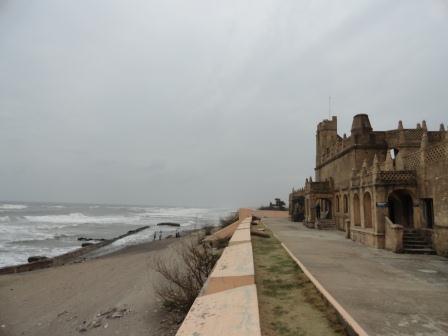Tranquebar - what kind of name is that? I was intrigued when I saw an advertisement about a photo exhibition about Tranquebar at the Dakshin Chitra. We were on a one day leisure trip early this week to Mahabalipuram from Chennai and had stopped at at Dakshin Chitra as part of the trip. The advertisement had the pictures of an old colonial style gateway, an expansive fort on a seashore and a temple on the edge of the sea. It also had a a caption '' Tranquebar - place of the singing waves''. For the rest of the trip, I was left wondering about this place I had never heard before.
After reaching home, I googled Tranquer and one of the first results that came up had this to say about Tranquebar ''
Tranquebar…the exotic name is an apt driveway to what lies beyond the
baroque Town Gate. Placed as a dreamy patch at the confluence of a
distributary of the river Cauvery and the Bay of Bengal, since the
1600s, this small town has been the drawing board of numerous trysts
that have lent Tranquebar a steep culture and heritage. An exquisite
playpen of Danish aspirations in India, Tranquebar, in its modest
alleyways that throw their bosom open to the sea, preserves a rustic
mood splashed against a captivating backdrop. Crisp mornings…the ever
tranquilizing sea…perceptions related to the British rule, the Danish
settlement, the German cultural link and nearby former French colonies
of Karaikal and Pondicherry, greet you in this heritage space which in
its heyday could have easily passed off as a fragment on the European
coast.
Tarangambadi, as the place is known in native Tamil, literally
meaning, “The land of the singing waves”, is a perpetual paradox. ''
Need I say more? A few days later, I was on my way to Tranquebar or Tarangambadi along with my wife and kids. We planned a 2 day trip and stopped at Chidambaram temple, Pichavaram lake and Poomphur before arriving at Tranquebar by about 4:30 pm in the evening. The day was very cloudy and the sea was quite rough. That only added to the suspense to our trip.
As we arrived the small village, the gateway welcomed us. The gateway was built by the Danish more than 200 years back.
As we moved past the gateway, we went through a narrow street which looked quite different from what one sees in small towns in Tamil Nadu. The street, known as Kongensgade(or the King street), has some interesting buildings that showcase the influence of European architecture.
A few hundred meters from the gateway stood a Church, which was built in the year 1718 and is currently thronged by the locals. The Church is well maintained and was well decorated as part of Christmas celebrations.
We drove further and could see the sea and the fort. Before getting into the fort premises, we sighted the statue of one of the christian missionaries that was built to mark the 300th year Anniversary of the Tranquebar mission(1706-2006).
We finally arrived at the fort. After paying a token entry fee of Rs. 5 per person, we entered the fort. The fort is quite small compared to many other forts we had been to. But that did not take away the charm of the fort. Overlooking the Bay of Bengal, the fort has stood there since the 17th century. The fort built by Danish East India company is known as Fort Dansborg and was initally established mainly for exporting pepper from India. Tranquebar came under Danish control in 1777 and was briefly under British control(1801-1814) before the British restored it to the Danes. In 1845, the British purchased all Danish settlements, including Tranquebar. The town used to be a busy port with good amount of trade. In fact, several Danish ships have landed here before the other neighbouring ports became popular.
Some of the rusted cannons lay proof of how aged the fort is.
Most of the interiors of the fort is not accessible to the public, except for a small part, which is now a museum. The museum has some interesting artifacts, including a copy of the treaty signed in 1620 between Denmark and the King of Thanjavur. It also has a list of all the Governers of the fort(including the British), the list of the ships that arrived at the fort, and a few sculptures and items brought from Denmark.
A few more pictures of the fort are below.
A few meters away from the fort is the building which used to be the Governer's Bungalow. Apparently it was crumbling, but the Neemrana group of hotels bought it and have restored it. (The tariff for the hotel is about Rs. 6000 per day/person). The hotel is now called '' Bungalow on the Beach'' and the hotels website has some great pictures of how the Bungalow looks before and after restoration(Can be accessed here).
There are a few other officers' buildings and churches(including the oldest Protestant Church in India-The Zion Church)
We completed our trip after a visit to the nearby temple facing the sea. The temple, known as Masilamaninathar Temple, was built during the Pandya regime in the 14th century is among the oldest buildings in the town.
Now I know that Tranquebar is not very intriguing and is indeed a charming little town.
Trivia - The Neemrana group of hotels claim that Tranquebar has the highest ozone content in India which ''relaxes, rejuvenates and prolongs'' one's life.
Location:
From Chennai - 280 km South
From Pondicherry - 120 km South
From Chidambaram - 30 km South
From Tiruchirappalli - 150 km East
Some additional information can be found at the blogs mentioned below.
a. http://tranquebar.in/about-tranquebar/history/ - It has some old photographs
b. http://in.lifestyle.yahoo.com/blogs/traveler/tranquebar-town-singing-waves-042732852.html
c. http://travel.sulekha.com/my-visit-to-tranquebar-danish-colony-in-tamilnadu-history-photo-blog_travelogue_3590
Subscribe to:
Post Comments (Atom)









No comments:
Post a Comment